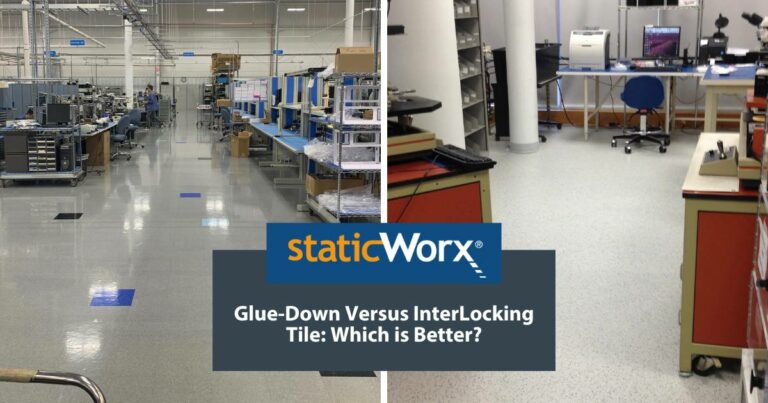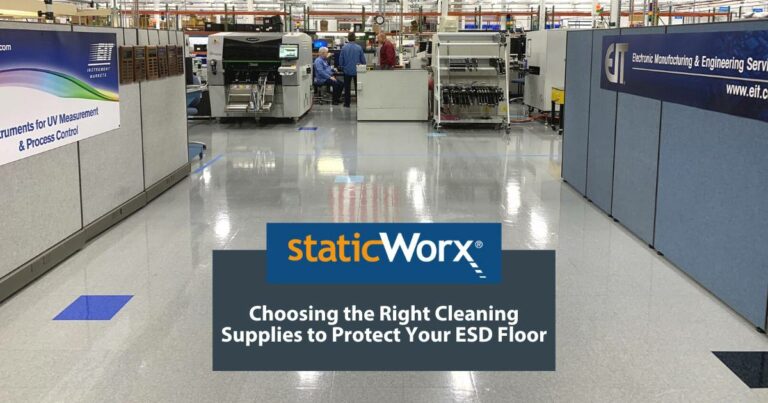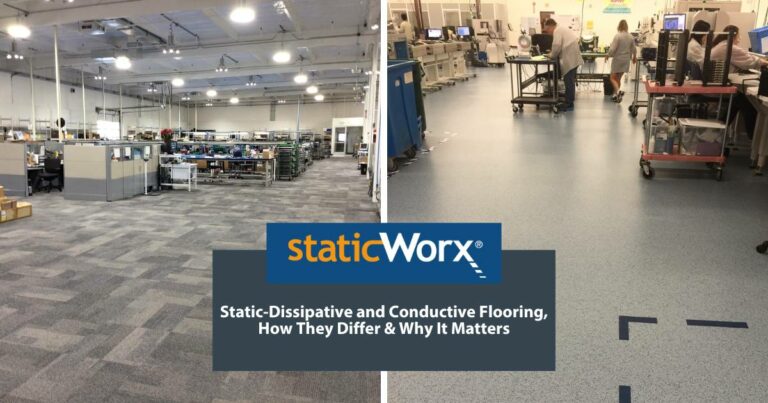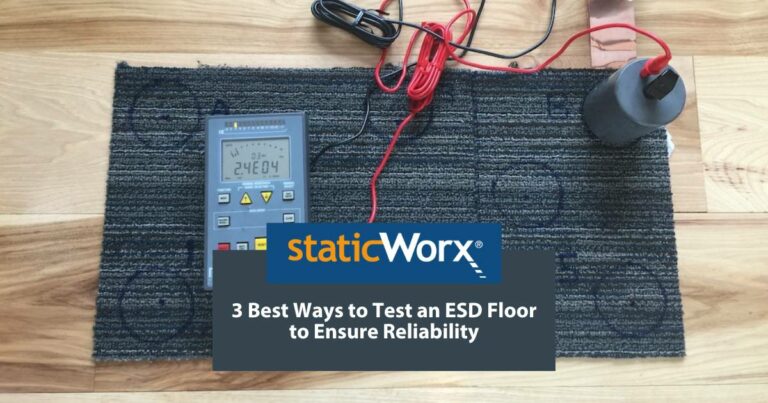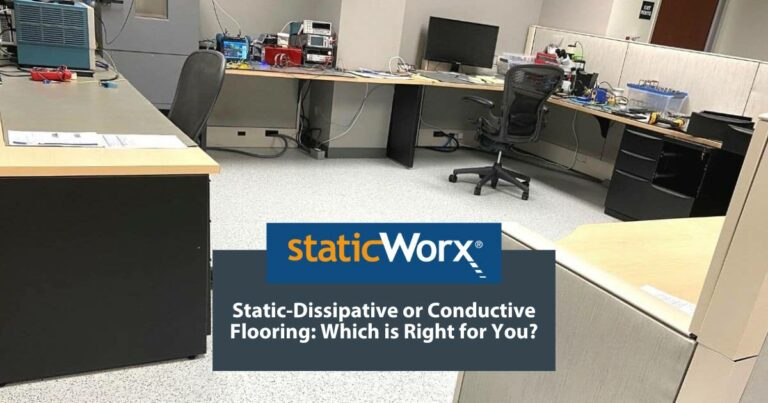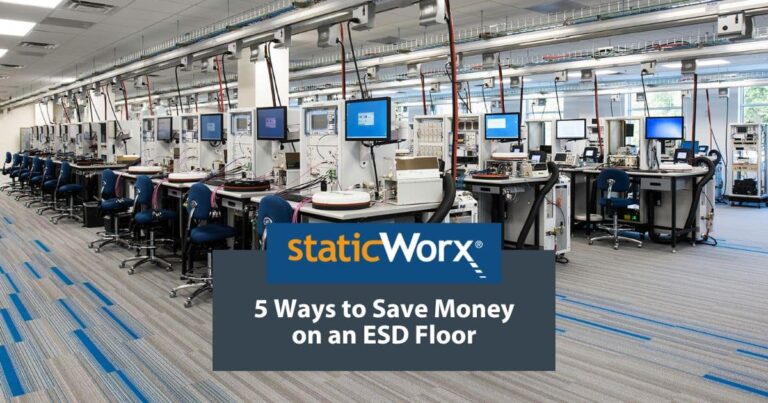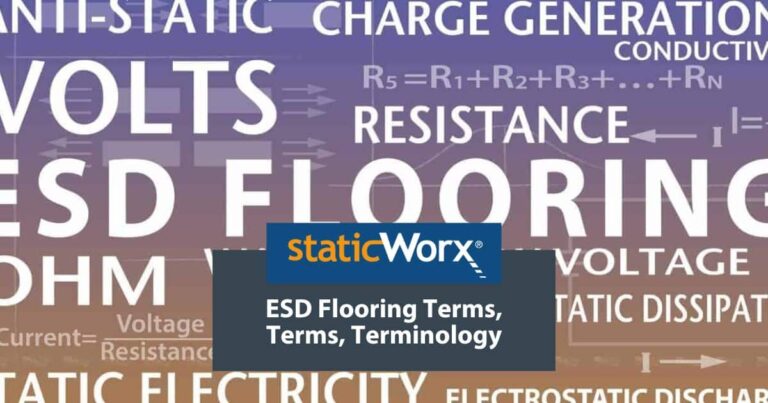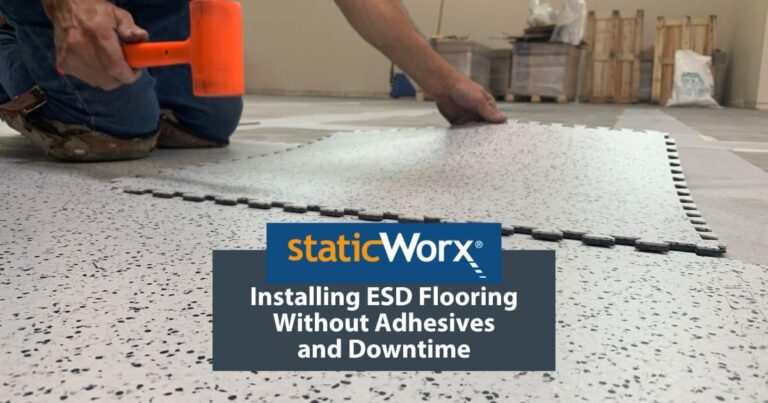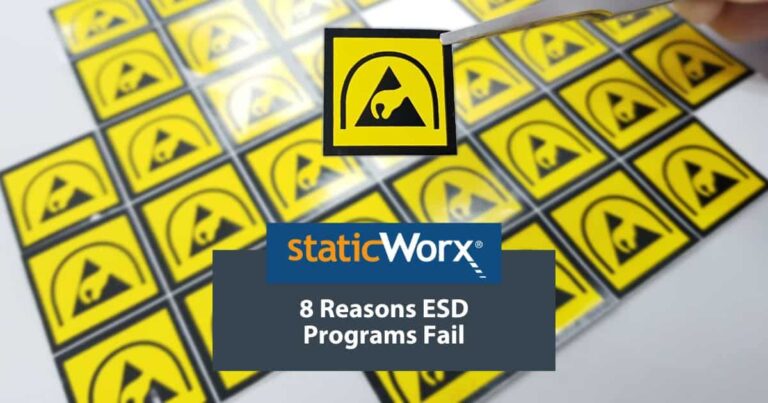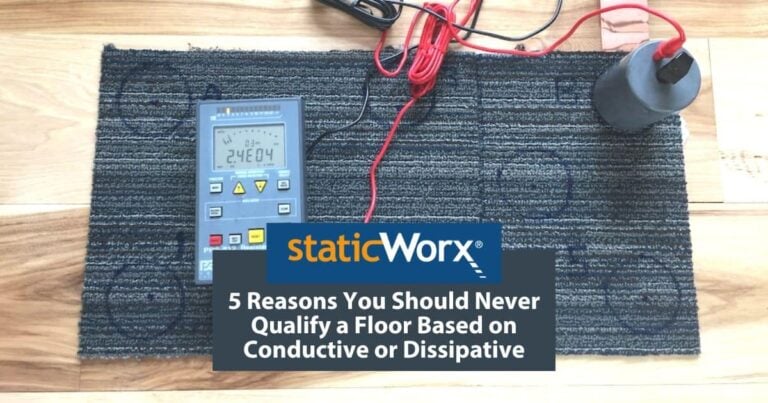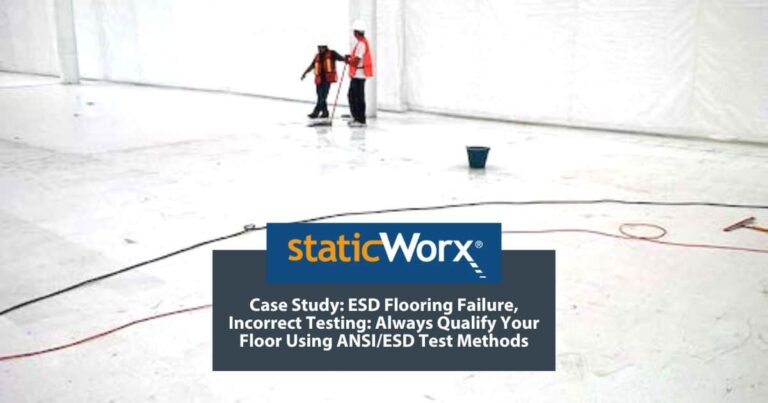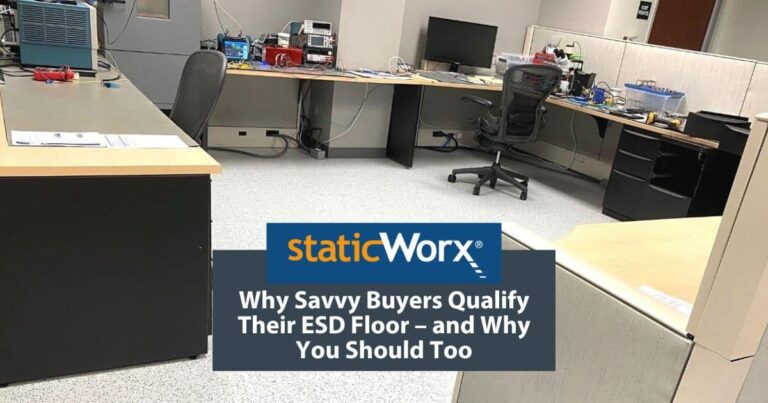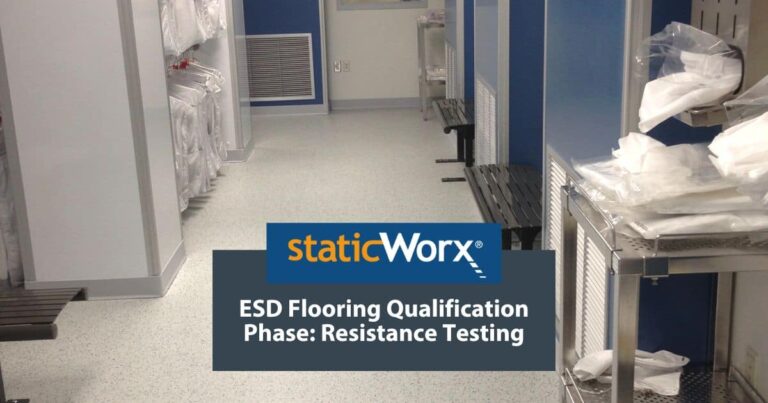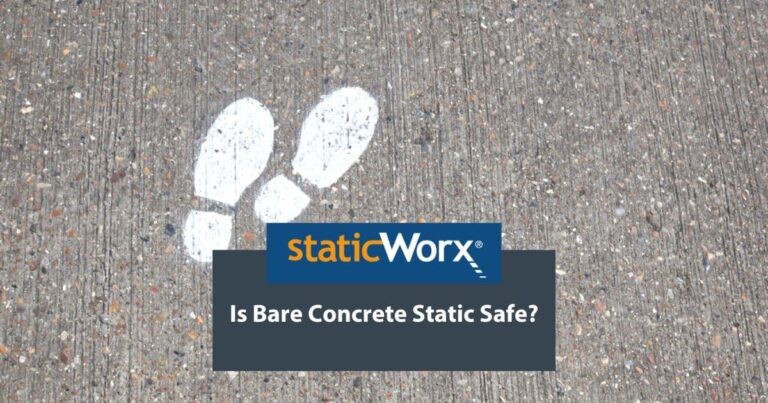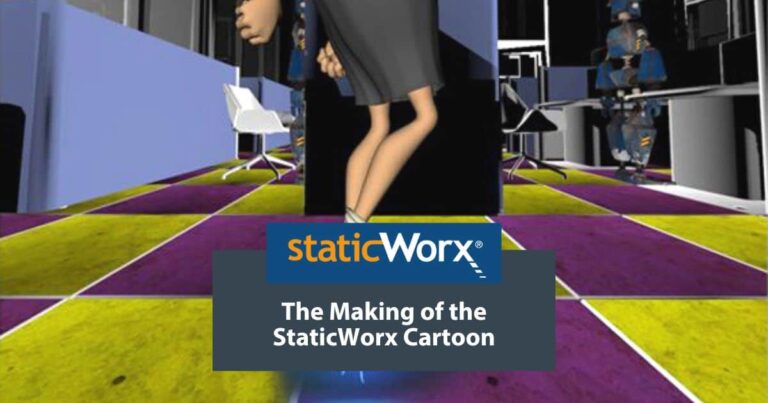Learn the differences between ESD solid vinyl tile and interlocking ESD tile. The post compares specs, installation, maintenance and intangibles.

Choosing the Right Cleaning Supplies to Protect Your ESD Floor
5 min read
An electrostatic discharge (ESD) floor is critical for mitigating static electricity in any facility that manufactures or handles sensitive electronic components or equipment. ESD floors are designed to prevent the buildup of static electricity (be antistatic) and dissipate charges to ground (have inherent, measurable conductivity). To maintain the effectiveness and electrical performance of an ESD floor, it is important to use the right cleaning products – i.e., products that will not damage the floor or degrade the floor’s conductive properties.
Identify Your Cleaning Needs
Before purchasing cleaning supplies for your ESD floor, first identify your cleaning needs. Some factors to consider include the frequency (how often you clean your floors?); the types of traffic (foot traffic? machinery?); the level of traffic (high, medium, low); and the types and amount of dirt and contaminants on the floor.
If your ESD floor is in a high-traffic area, exposed to a wide range of contaminants or in need of extreme cleaning or refurbishing, you may need a more powerful cleaner, such as StaticWorx EcoScrub, a cleaner/degreaser that can effectively remove dirt, grease, and other contaminants. If your ESD floor is in a low-traffic area or is only exposed to light contaminants, a milder cleaner like StaticWorx ScrubWorx neutral pH cleaner may be sufficient.

Understand the Properties of Your ESD Floor
Next, you need to understand the properties of the floor. ESD floors are typically made from carbon-impregnated materials such as carpet, vinyl, rubber, or epoxy. Conductive elements, such as conductive yarn or carbon filaments, are introduced in the manufacturing process. ESD flooring materials have different electrical properties and different requirements for cleaning.
ESD vinyl, the most common type of ESD flooring material, is typically cleaned using a neutral pH cleaner formulated specifically for ESD floors. Many rubber ESD floors, such as StaticWorx Eclipse rubber (EC and GF) are cleaned simply with water. ESD epoxy is the most durable and chemical-resistant ESD flooring material. Epoxy requires a non-abrasive scrubbing process and neutral cleaner, formulated for use on ESD epoxies.
The importance of an inherently conductive ESD floor
If You Use Conductive Finish or Wax On a Non-ESD Floor, You Must Perform Regular Resistance Tests
True ESD floors derive their conductivity from conductive elements, such as conductive fibers or carbon filaments, introduced into the material during the manufacturing process. An inherently conductive floor – i.e., the conductive properties are embedded in the material – should be permanently conductive. For example, the electrical performance (conductivity) of every StaticWorx ESD floor is guaranteed for the life of the floor.
It is possible to add conductivity to a non-ESD floor after the floor has been installed. This can be done by applying a topical ESD finish such as StaticWorx static-dissipative CoatZF emulsion. However, all topical finishes – whether it’s a static-dissipative emulsion, such as CoatZF, a conductive wax, polish or antistatic spray – wear off over time. You will not know when this happens. Conductivity is not something you can see or in any way perceive. To be sure your floor is performing properly, it is crucial to test its electrical resistance regularly, following the guidelines in ANSI STM 7.1. Without regular testing, you will have no way of knowing if the floor is still protecting your electronics from random ESD events.
CoatZF static-dissipative emulsion can also be used on inherently conductive ESD floors, such as AmeriWorx SVT or GroundWorx epoxy, to enhance their appearance, if desired. In this case, because the conductivity is derived from the floor, not the finish, the ESD properties are permanent and will not wear off.
Choose a Cleaner that is Compatible with Your ESD Floor
Once you have a good understanding of the properties of your ESD floor, you can look for a cleaning product that is compatible with the floor. Traditional cleaning products may contain chemicals that can damage or abrade the floor. Waxes/finishes may put a hard coating over the floor, potentially interfering with the floor’s capacity to dissipate static. That’s why it’s important to choose a cleaner designed specifically for use with ESD floors.
Look for a cleaner that is non-corrosive, pH-neutral and does not contain harsh chemicals such as bleach or ammonia. Always choose a cleaner that is non-abrasive, as abrasive cleaners can scratch the surface of the floor and affect its aesthetic appeal.
Choose a Cleaner that Meets ESD Standards
When buying a cleaning product for your ESD floor, it is important to choose a cleaner that meets ESD standards. ESD standards are designed to protect sensitive electronic components from harm caused by random electrostatic discharge (ESD) events. Random ESD events can damage or destroy sensitive electronic equipment.
Cleaners that meet ESD standards maintain its intended electrical resistivity (resistivity requirements vary by application). Non-ESD waxes, for example, can create an insulative surface that raises the electrical resistivity of the floor. Before and after cleaning, floors should measure within the intended electrical resistivity range.
Cleaners should also enable the floor to remain antistatic. That is, before and after cleaning the floor should inhibit body voltage – i.e., prevent static from building as people walk on the floor.
Measure conductivity, or electrical resistance, of the floor with an ohm meter, following procedures outlined in ESD STM7.1.
For electronics manufacturing and handling, the floor must measure < 1.0 x 10E9 ohms.
For end-user facilities, the floor must measure >1.0 x 10E6 and < 1.0 x 10E9 ohms.
Measure the antistatic properties of the floor (also called body voltage) by following procedures outlined in ANSI/ESD STM97.2.
In an electronics facility the floor should generate < 100 V.
In an end-user facility, it should generate < 500 V.
Read the Label and Follow the Manufacturer's Recommendations
When choosing cleaning products for your ESD floor, it is critical to read the label and follow the manufacturer’s recommendations. The label should provide information about the ingredients, pH level, and recommended usage. It may also provide information about the types of surfaces the cleaner is compatible with.
Following the manufacturer’s recommendations will help to ensure that the cleaner is used correctly and that the cleaning process does not damage the floor. Solid vinyl tile, such as AmeriWorx SVT, should never be buffed at a speed higher than 350 rpm as high-speed buffing can damage the surface of the floor. It is also important to follow any safety precautions listed on the label, such as wearing protective gloves or eye protection.
Consider Environmental Factors
When buying ESD floor cleaners and finishes, it is important to consider environmental factors such as temperature and humidity. Temperature and humidity can affect the conductivity of the ESD floor and can also alter the effectiveness of cleaning products.
Some cleaning products are formulated for use in high humidity environments or at specific temperature ranges, while others may not be as effective under these conditions. It is important to choose a cleaning product that is appropriate for the specific environmental conditions in which the ESD floor is located.
You may also wish to consider purchasing products that pass emissions testing, are low in VOCs and have no chemical irritants.
Buying the right cleaning product for your ESD floor is an important step in maintaining the performance of the floor. To ensure that you choose the right cleaning product, it is important to understand the properties of your ESD floor, identify your cleaning needs, choose a cleaner that meets ESD standards, and consider environmental factors. By following these guidelines, you can help to protect the integrity of your ESD floor and ensure that the floor continues to provide adequate, long-lasting protection against random ESD events, safeguarding your valuable equipment.
About StaticWorx, Inc
All StaticWorx posts are written by our technical team and based on industry standards and specifications, test data, independent lab reports and other verifiable data. We provide ESD training and offer CEU credits to architects. If you’re interested in an ESD training session or architects’ ESD workshop, give us a call: 617-923-2000.
Get in Touch
The form below will help us better understand your needs and get you as quickly as possible to the right person. We look forward to helping you solve your static problem!
You can expect a response within 24 hours. For faster service, please give us a call: 617-923-2000
"*" indicates required fields
Visit our privacy policy to find out how we process data.
More Blog Posts
To maintain performance, ESD floors require specially formulated products. We offer tips on what to consider when choosing cleaning supplies.
Static-dissipative floors transport harmful static charges to ground. Dissipative is also a term for flooring with a specific, measurable electrical resistance.
StaticWorx recognized as one of the fastest growing private companies in the U.S. 2023 marks StaticWorx fourth appearance on Inc. 5000 list.
Conductive and dissipative flooring protect electronics by transporting charges to ground, conductive at a quicker rate, dissipative slower & more controlled.
We explain the 3 main ways to test an ESD floor: Electrical resistance; body voltage & ESD audits, with advantages and reasons for each.
Three critical factors—application, industry standards & footwear—help you choose the best ESD floor, while ensuring the safety & efficiency of your operations.
StaticWorx Founder and President Dave Long shares three of his recommended reads: Quit, How to Change, and The Goal.
No matter how you slice and dice a project, an ESD floor is a major investment. This blog post examines five ways to keep undue costs down.
What’s the difference between static control and static resistant? Or anti-static flooring? Find out more in our blog post.
A major part of any ESD control program is getting proper flooring in place. How can one replace a floor without generating any debris? Learn more.
A well-designed, comprehensive, fully realized program is a must for manufacturers serious about ESD control. Learn why ESD programs fail.
ESD Floors should never be specified based on the descriptive terms conductive or static dissipative. Always base ESD specs on verifiable metrics. Find out why.
To comply with relevant ESD standards, test electrical properties using methods outlined in ESD S20.20. For best results require testing by an independent lab.
If the vapor barrier fails to adhere to the subfloor, tiles will lift. Bond test and manufacturer oversight are crucial to ESD floor installation success.
Blog Post: Conductive and Static-Dissipative Flooring: What’s the Difference?
The Layperson’s Answer
What’s the difference between conductive and static-dissipative flooring? Facts, analogies and images illustrate the difference in easily understood terms.
Qualifying an ESD floor helps ensure you get the floor you paid for. Find out why you should always qualify according to ESD S20.20
Qualification is the first step in selecting an ESD floor. Learn how to perform resistance tests to be sure the floor meets electrical & safety standards.
Will bare concrete control static? Learn why concrete floors are unreliable & what precautions to take if you must work on a bare concrete floor.
A look at how the StaticWorx cartoon, 'Conductive Flooring Does Not Mean Antistatic Flooring,' was conceived and created.
Learning Center Articles
- ESD Basics
- Installation & Maintenance
- Selecting & Specifying an ESD Floor
- Technical Information
- 7 Common Mistakes Selecting an ESD floor
- A Guide to ESD Flooring Selection
- Avoid Costly Failures: What You Need to Know When Specifying ESD Flooring
- Choosing ESD Flooring for:
- ESD Footwear: What Is It and When Is It Necessary?
- ESD Footwear for Electronics Manufacturing and Handling Applications
- Facility Managers’ Guide to Selecting ESD Flooring
- The Need for Due Diligence in Specifying Static-Free Flooring
- Standard of Care for Specifying Floors in Mission-Critical Spaces
- Understanding the Hidden Costs of ESD Flooring

StaticWorx high-performance static-control floors protect electronic components, explosives, and high-speed computers from damage caused by static electricity. ESD flooring is part of a system. Choices should always be based on objective, researched evidence. When you partner with us, we look at all possible items that may need to integrate with the floor, and, focusing on your goals and objectives, help you find the right floor for your application.





